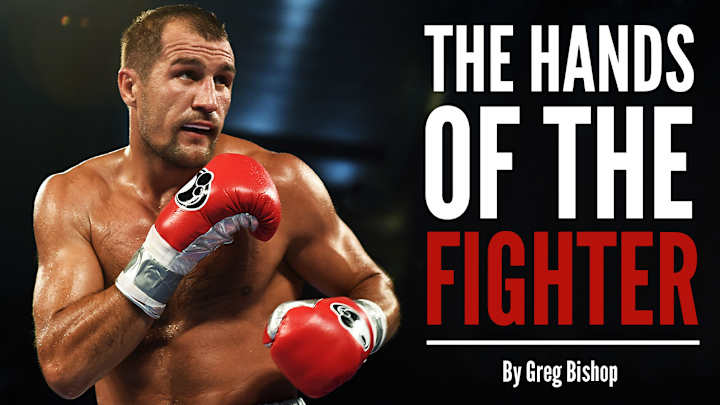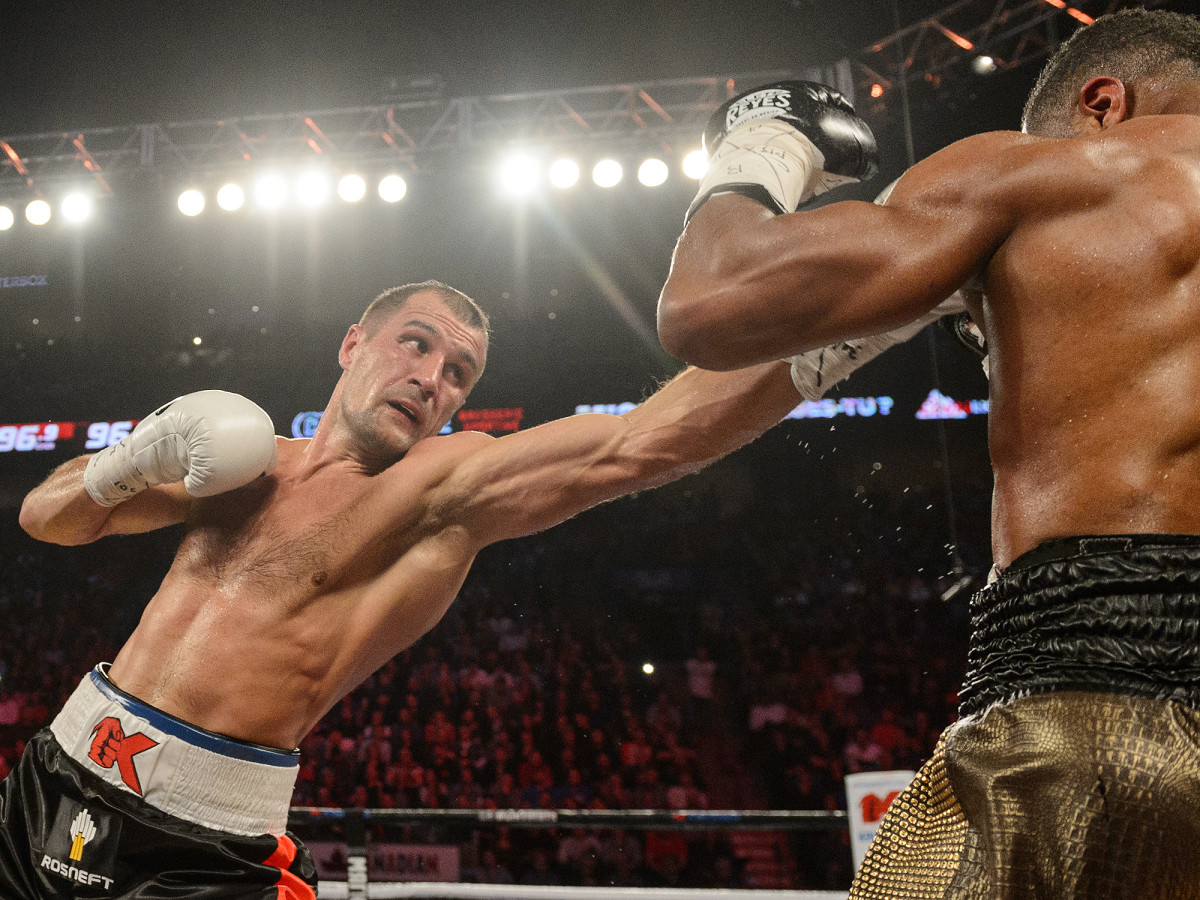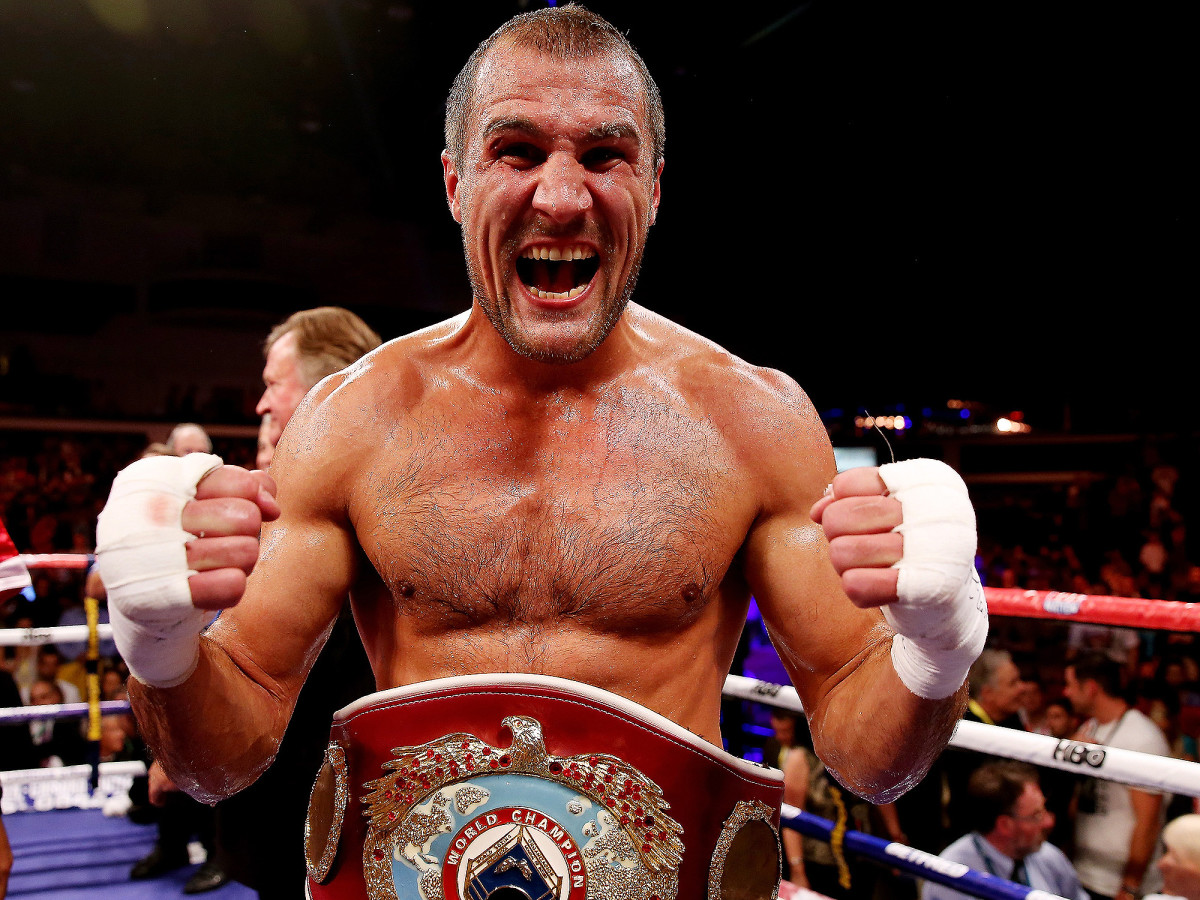'Life hits much harder than anybody': Sergey Kovalev's story, told through his hands

WESTLAKE VILLAGE, Calif.—Three middle-aged women recognize the boxer known as Krusher outside a coffee shop this fall. Sometimes that boxer—real name: Sergey Kovalev—can’t believe the life he lives is real. This is one of those times. The women sip soy lattes and carry designer handbags and one totes a Chihuahua who at this moment is barking at the undefeated light heavyweight champion.
“You’re the Russian boxer, right?” one says, as she introduces herself and asks for a picture.
Kovalev nods, poses and smiles. The women thank him. The Chihuahua yips and yaps.
The boxer holds up his hands as if to jokingly say don’t attack and that’s when I first notice the 10 fingers that appear to have gone 10 rounds with a meat grinder, the digits mangled, crooked and swollen—like trees that have grown sideways instead of straight up. It might seem obvious that someone who makes a living disfiguring other someone’s faces would damage the appendages that do his damaging. But nothing with Kovalev is obvious. If eyes are the window to the soul then Kovalev’s coarsened hands open the doorway to his life.
It’s a cloudless day in Southern California and Kovalev’s bout with Andre Ward—only the third fight in the history of The Ring magazine to feature two undefeated consensus top-five pound-for-pound boxers—looms on Nov. 19 in Las Vegas. Kovalev will need his hands in that one, obviously, to overcome Ward’s technical prowess.
Kovalev will need the right middle knuckle that doubled in size after his January rematch with Jean Pascal. (Kovalev won by referee’s technical decision in a bout in which, he admitted afterward, he carried Pascal for more rounds than necessary, in order to inflict maximum punishment.) He’ll need his left pinkie, which is propped up by a metal plate and dangles away from his hand, the result he says “not from boxing, but, like, from a gun.” He declines to elaborate but says he can’t bend that finger anymore.
He shrugs. “My hands, you know, they tell a story,” he says.
****
The enlarged knuckles on his right hand tell the story Kovalev doesn’t want to share. I first shook that hand on Nov. 2, 2013, across the street from Madison Square Garden. Gennady Golovkin, the middleweight knockout artist for whom Kovalev once worked as a sparring partner, was fighting that night, on the same card as a pair of heavyweights, Magomed Abdusalamov and Mike Perez. Kovalev was at the HBO pre-fight party, blissfully unaware of what would happen later—that Abdusalamov would end up in the hospital with injuries from which he would never recover. That his brain would bleed. He remains in a vegetative state.
At the coffee shop in California, Kovalev turns philosophical about boxing and its inherent violence. Although his actions against Pascal indicated otherwise, Kovalev isn’t entirely comfortable with what happens in the ring. “Believe me,” he says. “Life can punch much harder than anybody.”
That seems like a natural segue to Dec. 5, 2011 and the night Kovalev faced Roman Simakov in Ekaterinburg, Russia. I ask Kovalev when life punched him hardest, easing into his bout with Simakov at DIVS Sports Palace that night. To this question, and several follow-ups, Kovalev responds with a long, blank, intimidating stare. “I don’t like to go there, remember right now, pick up some things in my memory,” he says in broken English. “Life hits much harder than anybody. Like, it’s my answer.”
That leaves friends and trainers to piece together how Simakov’s death changed Kovalev, who has only addressed the matter once in any sort of depth, with Yahoo’s Chris Mannix earlier this year. In half a dozen interviews, their answers speak to why Kovalev tries so hard to move on, to forget.
How his hard, thudding right hands landed over and over.
How Simakov was carried out on a makeshift stretcher as Kovalev’s arms were raised in triumph.
How Simakov fell into a coma.
How Kovalev sped to Simakov’s dressing room, where he saw that his opponent had turned blue.
How Simakov had brain surgery.
How Simakov never regained consciousness.
How a friend at the hospital updated Kovalev on Simakov’s condition.
How it never improved.
How Simakov died three days after the fight.
How Kovalev called Simakov’s family.
How Simakov’s family blamed him for their son’s death.
How Kovalev cried and prayed.
How fans at fights screamed murderer at him.
How others suggested he had fought with loaded gloves.
How Simakov’s family sought a criminal investigation.
How Kovalev retreated from public view.
How writers bombarded him with questions.
How he promised to dedicate the rest of his career to Simakov.
How he can never shake what happened.
How it changed him.
“Listen, we as fighters have a thing about that,” says John David Jackson, Kovalev’s trainer, who fought 41 bouts at super welterweight. “If you think about your opponent dying you shouldn’t be in the ring. That should be the last thing you think about. You don’t wish that on anybody. But it happens.”
Jackson says this so nonchalantly that it’s striking and the conversation momentarily halts. But his words ring with the brutal truth. There’s a Web site, Death under the Spotlight: The Manuel Velazquez Boxing Fatality Collection, which documents boxers who died from boxing. Between 1725 and now such deaths number more than 2,000. More than 2,000 men who died like Simakov. “What’s unusual about Kovalev,” says HBO commentator and boxing expert Jim Lampley, “is that 99% of the time when one fighter dies in the ring two careers die.
“That’s not what happened with Sergey Kovalev.”
****

The index finger on his left hand tells the story of life in Kovalev’s hometown, Chelyabinsk, a hardscrabble city of more than a million people that is home to metal factories that Kovalev says build such things as tractors, sinks and … tanks. Chelyabinsk was even hit by a meteor in 2013.
The boxer freely admits that Jean-Claude Van Damme action movies inspired him to seek out street fights. He once watched as a mob beat a man to death. He hung posters of Van Damme, Sylvester Stallone and Arnold Schwarzenegger on his bedroom walls. Anyway, in one particular street fight, Kovalev landed a left with the force of a meteor on a man’s skull, bending his index finger at an almost 45 degree angle. He didn’t even feel it. What he felt was the kick to the groin. “It hurt, you know, my egg,” he says, gesturing down below. “Like, I wasn’t walking. I had to lay down for three to four days. I got an operation.”
“Yeah, my craziest ages was 16 to 25,” he continues. “Just boy, you know.”
By then, Kovalev’s father had abandoned his family—a loss, Kovalev’s promoter Kathy Duva says—that “defined him for the rest of his life.” (Kovalev says he has a relationship with his father now. He didn’t see him between ages 3 and 12.) With his dad gone, Kovalev washed windows and re-sold newspapers and pumped gas as a child. As he grew stronger, he picked up shifts at the loading docks, moonlighting as a bodyguard.
He also stumbled into boxing as a teenager, after his stepfather saved for months to buy him ice skates to play hockey and someone in the neighborhood stole them. With nothing to do, Kovalev accompanied a friend to a gym. His trainers there emphasized boxing as a pathway to masculinity. “Like a real man,” Kovalev says. “Don’t cry if you like get punched, bloody your nose, or punch your hard.” Except that Kovalev did cry. Poor form kept causing injuries to his … hands. “You can’t be like a girl,” the trainers told him.
Day after day, he returned to the gym, hardening his hands. In the evenings, too, he used them, but not in the way that anyone might reasonably expect. In his down time, Kovalev made paper models of cars and airplanes, cutting the figures out of magazines, and carefully trimming and folding and painting his masterpieces. He saved one cherry red Jeep Cherokee that years later his sister’s toddler tore apart. “I fought with my sister about this,” Kovalev says. “Like, it was my best job, you know.”
Kovalev’s hands sustained him. They gave him purpose. They made him whole. In the ring, or fashioning those models, he didn’t have to worry about the father who left, or the refrigerator empty except for two eggs. He didn’t have to think about how broke he was, how bleak his future seemed. He competed in more than 200 amateur bouts and yet never ranked among his country’s top boxers. He fought like an action hero from the movies but he was the anti-Van Damme—all substance, no splash.
Now, he might be the closest thing American sports has to real-life action antihero. “He’s Han Solo,” Duva says, laughing. A street fighter thisclose to becoming pound-for-pound king. I asked him if he feels like Van Damme. “Not think,” he says. “I know.
“Boxing gyms, they hang my poster on their wall.”
****
Seven years ago, Kovalev left Russia for the United States. The theme of his life continued there: He had to fight for everything. There would be no handouts.
His manager, Egis Klimas, paid for all of Kovalev’s expenses, from his walk-around money to his car to the purses for his fights. They started in North Carolina, under the tutelage of Don Turner, who once trained heavyweight champion Evander Holyfield.
Kovalev could count some of the crowds in his early by hand and while fighting inferior opposition. He boxed in Greensboro, N.C., Colombia, S.C., Tacoma, Wash., Fairfax, Va., and Louisville, Ky. He fought at the Playboy Mansion, the ring set up near the famous grotto in Hugh Hefner’s expansive backyard. He sometimes wondered if Hefner watched out the windows of his house, and one time, he spied Hefner ringside, clad in a bathrobe, a blonde hanging on each arm. He made about $4,000 for those fights but boxing cognoscenti started to notice all the knockouts, even as the major promotional companies passed on Kovalev.
Even celebrated ring announcer Michael Buffer, of let’s-get-ready-to-rumble fame, caught one of the Playboy Mansion bouts. “There was just something about him,” Buffer says. “He had this Sergeant Slaughter chin and this tough-guy look to his face. I wanted to watch him.”
Klimas eventually set Kovalev up to spar with Golovkin, and there’s an infamous story about how the boxer known as GGG knocked Kovalev silly in one session. It may be partly true. Jackson says Kovalev told him Golovkin caught him with a savage body shot that knocked the wind out of him. “He said he didn’t want to hurt his friend, so he stayed down,” Jackson says.
The wins accumulated like bent digits on Kovalev’s hands. He signed with Duva and Main Events three years ago. Duva asked him what he wanted. “To fight for a world title,” he said.
“He had this intensity coming out of his eyes,” Duva says. “This focus that was so complete, so total. He reminded me of Sugar Ray Leonard. He didn’t blink the way that Ray didn’t blink.”
Kovalev won that title, knocking out Nathan Cleverly in 2013, less than two years after Simakov’s death. Duva asked him that night what he wanted to do next. “Unify,” he said, meaning he wanted to capture all the light heavyweight championship belts.
The march continued, a hands-on process, as Kovalev bludgeoned his way to boxing recognition. His knockouts caught the attention of Bernard Hopkins, the legendary boxer known as the Alien because he fought into his 50’s. Kovalev promised to knock the Alien back to Mars.
Instead, he displayed a technical proficiency he had rarely shown before. He knocked Hopkins down and beat him handedly, but Kovalev did so by unanimous decision. He didn’t look for the knockout. He secured the win. His son, Aleksandr, was also born that week, marking two major milestones for Kovalev. Duva stood close enough in the ring after the Hopkins fight to hear Kovalev’s vanquished opponent whisper in his ear. She recalls Hopkins saying, “You’re going to be the light heavyweight champ as long as you want to be.”
“Well,” Hopkins says, “he put my ass on the canvas, so …”
Hopkins found Jackson in the ring that night. “Damn, Johnny, I didn’t think he could punch like that,” Hopkins said.
Kovalev won his next three bouts, as talk of a match-up with Ward intensified, and all he had to do was return to Russia in July and defeat Isaac Chilemba for the blockbuster Ward bout to materialize. There was, though, one catch. Kovalev would be returning to the same arena in which Simakov sustained the injuries that killed him—injuries delivered by Kovalev’s hands.
In Russia, Kovalev took on too much, according to Jackson, Duva and others. He distributed his own heavy load of tickets. He picked over small details in the promotion. It had been his choice to return there, but that almost backfired. He topped Chilemba in a lackluster unanimous decision. Afterward, Kovalev (30-0-1) refused to blame anyone—or anything—other than himself. He had secured the Ward fight, at least. But Duva and others wondered if there was more going on there than he cared to admit.
“There was a point where he had Isaac and didn’t finish him,” Duva says. “It was around the same time that the Simakov fight was called. The same point in the fight. I don’t know if Sergey would admit that that impacted him. But I wondered about it at the time. And that scared me.”
I ask Kovalev about his return to Russia. He waves both hands dismissively. “Yeah, great time,” he says, unleashing a massive yawn.
****

Kovalev-Ward takes place this weekend, and while it hasn’t registered with mainstream media in the way it should have, it’s a rare meeting between two of the best boxers in the world who haven’t lost and are in their primes. As if Floyd Mayweather Jr. had fought Manny Pacquiao in 2009 rather than 2015. “Those of us in the cult,” Lampley says, “have been waiting for this for a long time.” Agree.
Boxing’s problem is … thatwait. The promoters who shield their best fighters from top opposition to boost their records and make more money. The network executives who don’t demand the top fights. The boxers themselves aren’t to blame; only they know the risk inherent in climbing in that ring, and they pay those managers and promoters, entrusting their careers to them. Duva notes that the last time two undefeated, top five P4P boxers fought was in 1999 (when Oscar De La Hoya took on Felix Trinidad). “That’s right about the time that Floyd Mayweather became Floyd Mayweather, when he started his dominant run,” she says. “That also coincided with this period when the sport has dropped tremendously in popularity. I don’t think that’s a coincidence. This idea that you don’t challenge yourself to try and keep your record pure is insanity. But that’s what we’re seeing these days.”
Kovalev is not that. He fights anyone, anywhere, in their hometowns, in their favorite arenas, without the usual demands that hold up bouts like this one. “He got mad respect from me,” Hopkins says, “for a long, long, long time, if not forever. He wants to prove he’s the best, and that’s my kind of music, man. I’m one of those, and I’ll tell you this, buddy: We’re a dying breed.”
“Is there risks in that?” Hopkins continues. “Absolutely.”
Kovalev knows those risks as well as anyone, knows what can happen when he steps inside that ring. He says he’s moved past Simakov’s death and all the pain. But it’s hard to watch that stare, to hear the stammering answers, and believe him.
Jackson expects Kovalev to beat Ward, which is, of course, not all that surprising. He points to Ward’s extended layoff, the three fights in the last five years. He says Ward won’t know how hard Kovalev punches until a glove lands on Ward’s face. Lampley says history indicates that the “scientist usually beats the detonator” when their skill level is close to equal. But even he’s not sure.
Kovalev? Well, he is certain. He rises from the table at the coffee shop, and I ask if I can take a picture of his hands. He says no, oddly, and begins to walk away. Surprised, I ask again. He shakes his head.
He continues walking and turns back and shouts. “Hey, is this the finger you want a picture of?” he asks, and he stands there, smiling, laughing, holding up only one finger—the middle digit, on his right hand. And I’m reminded.
“My hands, you know, they tell a story.”
